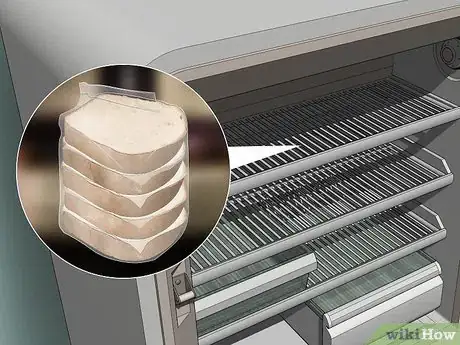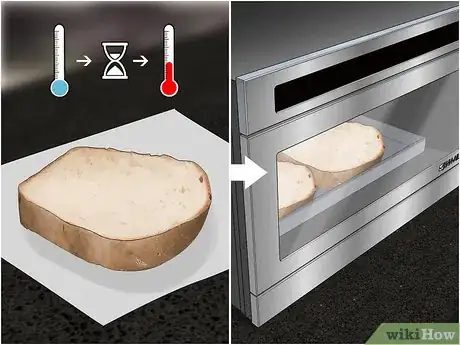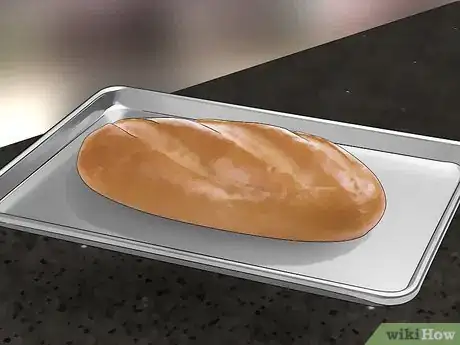This article was co-authored by wikiHow Staff. Our trained team of editors and researchers validate articles for accuracy and comprehensiveness. wikiHow's Content Management Team carefully monitors the work from our editorial staff to ensure that each article is backed by trusted research and meets our high quality standards.
There are 8 references cited in this article, which can be found at the bottom of the page.
wikiHow marks an article as reader-approved once it receives enough positive feedback. In this case, several readers have written to tell us that this article was helpful to them, earning it our reader-approved status.
This article has been viewed 214,865 times.
Learn more...
Keeping bread fresh can be a challenging task for anyone, especially for smaller households and those living in hot, humid climates. Learning to store bread correctly is the easiest way to keep mold away, and to enjoy every loaf to its last crumb.
Steps
Freezing the Bread
-
1Cut bread into portions or slices. Cutting a frozen loaf is not easy and you won’t have to thaw the whole loaf with every use.
-
2Wrap up the loaf tightly. Wrapping the loaf with wax paper or foil will help keep moisture with the loaf and prevent freezer-burn. With soft bread, you can place wax paper between slices to prevent them from sticking together.[1]Advertisement
-
3Place the loaf in a freezer-safe bag. Remove as much air as possible by folding the bag around loaf as you close it after every use. That way the loaf should keep fresh for up to six months.[2]
-
4Allow the bread to thaw. When ready to eat, let pieces thaw in foil or paper before reheating in order to let them reabsorb the moisture that migrated to the wrapping. This will ensure the texture of the bread is the same as the day it was first frozen.[3]
Storing in Cool, Dry Place
-
1Invest in a breadbox. Place your breadbox in a cool area away from heating elements that can accelerate mold growth. And since mold spores live in oxygen, the container should be airtight to keep the population low.[4]
-
2Keep the bread dry. Avoid touching the loaf with wet hands and never seal the loaf with visible moisture around it. This moisture when left at room temperature will accelerate mold growth.[5]
-
3Avoid the refrigerator. The temperature range of fridges can help against mold, but will make the bread go stale much faster. Unlike the freezer, the fridge will change the starch alignment in the bread, changing the texture of the bread greatly and quickly. [6]
Making Longer Lasting Bread at Home
-
1Incorporate sourdough starter into recipe. Sourdough starter is basically a usable form of wild yeast which increases the bread’s acidity, deterring mold, as well as staleness.[7]
-
2
-
3Add some natural preservatives. Adding natural preservatives like lecithin or ascorbic acid help maintain moisture while reducing yeast and mold counts. Ingredients like garlic, cinnamon, honey, or clove also naturally fight mold growth, but will obviously influence the flavor significantly. [10] [11]
Community Q&A
-
QuestionWhat are the problems of mold growth?
 Community AnswerMold growth can cause serious illnesses if you eat it.
Community AnswerMold growth can cause serious illnesses if you eat it. -
QuestionCan I keep my bread in the fridge between uses?
 Community AnswerIt's not recommended. The refrigerator will dry out your bread and cause it to become stale faster. Room temperature is best, or the freezer if you'd like to store it long term.
Community AnswerIt's not recommended. The refrigerator will dry out your bread and cause it to become stale faster. Room temperature is best, or the freezer if you'd like to store it long term. -
QuestionHow do I store assorted bread?
 Community AnswerStore it in a cold place, free of moisture that could lead to mold, such as a refrigerator. This way, it will last longer.
Community AnswerStore it in a cold place, free of moisture that could lead to mold, such as a refrigerator. This way, it will last longer.
Warnings
- Do not breathe in or smell bread after signs of mold as it may cause respiratory problems.⧼thumbs_response⧽
- Do not consume bread with any signs of mold.⧼thumbs_response⧽
References
- ↑ http://www.thekitchn.com/how-to-store-reheat-bread-advice-from-a-baker-175014
- ↑ https://www.hunker.com/12445295/how-to-keep-bread-from-molding-in-hot-weather
- ↑ http://www.thekitchn.com/how-to-store-reheat-bread-advice-from-a-baker-175014
- ↑ https://www.hunker.com/12445295/how-to-keep-bread-from-molding-in-hot-weather
- ↑ https://www.craftsy.com/blog/2014/03/how-to-store-bread/
- ↑ http://www.thekitchn.com/how-to-store-reheat-bread-advice-from-a-baker-175014
- ↑ http://digitalcommons.unl.edu/rurals/vol2/iss1/5/
- ↑ https://www.tablespoon.com/posts/how-to-keep-bread-from-molding
- ↑ https://www.browneyedbaker.com/italian-bread/
About This Article
To prevent mold from growing on bread, keep the bread in a sealed, airtight container that's stored in a cool spot. If you're worried you won't eat it all before it goes stale, you can freeze the bread so it stays fresh and doesn't develop mold. Just cut the bread into slices, wrap the slices in wax paper, and put them in a sealable freezer bag. Then, store the bread in the freezer for up to 6 months. To learn how to bake bread that lasts longer, scroll down!

































































